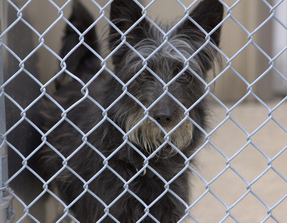 National Puppy Mill Awareness Day is recognized in late September of each year. It is a date used by animal welfare advocates across the country to bring awareness to the topic of the commercial dog breeding industry and to what many people now call "puppy mills." I believe, as do many of my advocacy contacts, that once the American public is educated on the topic of mills they simply will not stand for them. I have written on the topic of mills a lot recently in advance of this annual observance and as a result of my volunteer work for nonprofit groups who focus on mill dogs and ridding our society of this insidious industry. Although there are some differences of opinion on what the phrase "puppy mill" means, it refers to two separate businesses for me. For me, a puppy mill is: 1) any dog breeding operation, large or small, where the focus is on profit and where the well-being of the dogs themselves is of little concern; or 2) any commercial dog breeding operation where large numbers of dogs are bred for profit, regardless of the conditions in which those dogs are housed. Although I am not a fan of breeding dogs, I fully recognized that there is such a thing as a responsible breeder. There are people who breed and then sell dogs while taking excellent care of the parent dogs and while doing all they can to perpetuate breed standards and have healthy puppies for people to buy as family pets or to use in some service capacity. There is a continental divide between a responsible breeder and a puppy mill, no matter the size of the mill. Most of the people I know who have companion animals are good people who mean well, regardless of how they acquire their pets. Most of them just don't think about the subject of puppy mills because they don't feel personally affected by it. Those people I know who are not "animal people" and who don't have pets at all consider themselves further separated from the topic of mills because they don't think mills have anything at all to do with them. But, you see, they do. We are all affected by puppy mills and the commercial dog breeding industry due to one factor: money. When it comes to bringing a new dog into a home, people have a lot of options. They can buy a dog at a pet store and will probably be told the dog comes from a licensed USDA kennel (which in all likelihood is still a puppy mill). They can buy a dog through the internet using a website. They can buy a dog from a local breeder who will probably let them meet the parent dogs and see the conditions in which the dogs live. They can get a dog from a friend or family member. They can get a dog from a flea market or from the parking lot of a store or strip mall. They can get a dog through a newspaper ad. Or they can get a dog from a shelter or a rescue group. Although we don't like to think of it this way, the business of marketing and selling dogs is big business. Many of us react to the marketing we see much like we do for other products and with little regard for the fact that we are actually talking about a living, breathing, sentient creature who will spent 10 to 20 years with us and have the cognitive function of a toddler. On one end of this options spectrum we have the commercial dog breeding industry. Commercial dog breeders, both large and small, produce millions of dogs every year. Some are sold at auction much like other forms of livestock, some are distributed to pet stores across the country by Choice Puppies (formerly known of as the Hunte Corporation) in industrial tractor-trailers, some are sold on-line using polished looking websites (which bear little resemblance to the conditions in which the dogs actually live), some are sold through newspaper ads and some are sold in Walmart parking lots. Regardless of how those dogs get to us - the consumer - we're talking about millions of dogs being infused into the pet industry each and every year. Those in breeding circles would argue that the dogs are bred simply to meet public demand and they are, to a degree, correct. They would tell you that there is a demand so they create the supply. The bigger story is that we have been conditioned as a society for more than a hundred years to believe that pure bred dogs are superior to mixed breed dogs. We have also been conditioned to judge dogs the way we do other mass-produced products: be equating cost with value or worth. Surely, the argument goes, the $3,300 dog from a pet store is superior to a dog from a rescue group. Surely the $2,000 dog from a breeder is superior to a dog from an animal shelter. For all of our talk and back slapping to congratulate ourselves for being such an animal friendly society, we really are in many ways just a huge society of dog snobs. We are told that pure bred dogs or certain breeds of dogs are superior (when they often have a host of health issues, many of which have been bred into them to create a certain "look"). We are told that mixed breed dogs or certain breeds of dogs are either inferior or inherently dangerous. And we just buy all of it without exercising any independent thought at all because it's easier and because it's what we've been doing as long as anyone can remember.  On the opposite end of the options spectrum, we have shelter and rescue animals. At the same time that dogs are being bred by the millions, we are destroying dogs by the millions in municipally funded buildings we have the arrogance to call animal "shelters" even though most should just be called disposal facilities. Yes. Some of those animals we destroy using your and my tax dollars are truly suffering and for those animals, euthanasia is the only responsible and merciful alternative. There are also dogs entering our animal shelters who are genuinely so broken, for a host of reasons, that they are a risk to public safety and cannot be adopted out into homes in our communities. The rest of the animals we destroy in shelters in all but the most progressive communities are healthy and treatable animals whose only mistake is one of being unfortunate enough to have ended up in a building where they are treated as disposable. (It is estimated that 25 to 30 percent of shelter animals are pure bred.) In some communities, as many as 90% of shelter animals are destroyed using our tax dollars while we call it euthanasia or "putting them to sleep" or "putting them down" or some other euphemism to make ourselves feel better about the process. The vast majority of them either were, or could have been, someone's beloved pet. The consequence of this culture of killing savable animals is dire. Because we destroy them using our collective funds, we are conditioned to believe that something must be wrong with them or that they are somehow not worthy of sharing our homes and our lives with us. Nothing could be further from the truth, but this form of negative bias is incredibly difficult to overcome. When we add to the negative stereotype about shelter animals the fact that they are poorly marketed for the most part and it's no wonder that many people would never even consider adoption a dog from an animal shelter. Back to the connection and why you should care about and learn about National Puppy Mill Awareness Day. Even if you are sure you have never financially supported a puppy mill or you are sure that your dog came from a reputable breeder, the subject of puppy mills and the commercial dog breeding industry affects all of us. We produce dogs by the millions when we already have millions of great dogs already needing homes. As long as we allow dogs to be produced in this volume and we ignore our broken animal sheltering system, people will continue to get dogs from sources other than animal shelters and rescue groups. And we will continue to destroy animals by the millions using our tax dollars for no good reason at all. It is our public shame. But it is also something we can all learn about so we can make better individual choices which affect us all. I encourage you to find a Puppy Mill Awareness Day event near you and attend. Many are family friendly so you can bring your children and help educate them while you are educating yourself. Perhaps if you learn a little more about where our dogs come from, you will consider making better choices in the future which are more consistent with your individual values and with our values as a society. If you are not able to attend an event, I encourage you to learn more about this industry. You may not think you are supporting puppy mills, but in the end, we are all paying for them. ASPCA Puppy Mill Information Dog by Dog Harley, The Little Dog with the Big Dream National Mill Dog Rescue National Puppy Mill Project The Puppy Mill Project The Dog Merchants
2 Comments
Coyote Windsong
9/12/2016 03:33:12 pm
Another way puppy mills effect all tax payers is when mills are finally found to be so deplorable (which is happening more and more) and the dogs are finally removed, the community that the mill is located in bears the burden of housing and vetting the dogs, which can cost hundreds of dollars for each dogs. Some states have laws that abusers must pay for the costs of the dog removed from them (not sure if the money is ever collected), but many states have no laws that hold the abusers responsible.
Reply
Paws4Change
9/12/2016 03:41:03 pm
This is an excellent point and absolutely true, particularly related to backyard breeders and mill operations which are not really on the radar of the USDA. When there is a mill seizure in a community, it often falls on the animal shelter in that community to take possession of the dogs and care for them using taxpayer dollars.
Reply
Your comment will be posted after it is approved.
Leave a Reply. |
AuthorI am an animal welfare advocate. My goal is to help people understand some basic issues related to companion animals in America. Awareness leads to education leads to action leads to change. Archives
July 2024
Categories
All
image courtesy of Terrah Johnson
|
 RSS Feed
RSS Feed